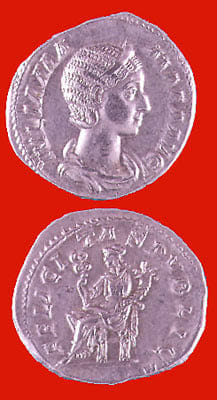Silver Denarius of Julia Mamaea, 222 CE - 235 CE
Silver
C.538
Obverse: Diademed and Draped Bust of the Empress Facing Righ Reverse: Felicitas, Enthroned to the Left, Holding a Caduceus and a Cornucopia Julia Mamaea was the eldest daughter of Julia...
Obverse: Diademed and Draped Bust of the Empress Facing Righ
Reverse: Felicitas, Enthroned to the Left, Holding a Caduceus and a Cornucopia
Julia Mamaea was the eldest daughter of Julia Maesa, that intrepid strong woman of Roman politics during the Severan period. Her son became the emperor Severus Alexander after his brother, the degenerate Elagabalus, was deposed and murdered by the Praetorian Guard. Severus Alexander was the exact opposite of his brother. He gave all the signs of turning out to be a responsible emperor who would govern wisely and not fall into the depravity that characterized his brother’s reign. Both he and his mother were under the control of the powerful Maesa until she died in A. D. 226. At this time Mamaea, last of the strong Severan women, took over the role of dominating and directing the man who occupied the throne. Julia was killed by Roman army officers along with her son in 235 A. D.
How many hands have touched a coin in your pocket or purse? What eras and lands have the coin traversed on its journey into our possession? As we reach into our pockets to pull out some change, we rarely hesitate to think of who might have touched the coin before us, or where the coin will venture to after it leaves our hands. More than money, coins are a symbol of the state that struck them, of a specific time and location, whether contemporary currencies or artifacts of a long forgotten empire. This stunning hand-struck coin reveals an expertise of craftsmanship and intricate sculptural detail that is often lacking in contemporary machine-made currencies. This ancient coin is a memorial an emperor’s mother passed from the hands of civilization to civilization, from generation to generation that still appears as vibrant today as the day it was struck.
Reverse: Felicitas, Enthroned to the Left, Holding a Caduceus and a Cornucopia
Julia Mamaea was the eldest daughter of Julia Maesa, that intrepid strong woman of Roman politics during the Severan period. Her son became the emperor Severus Alexander after his brother, the degenerate Elagabalus, was deposed and murdered by the Praetorian Guard. Severus Alexander was the exact opposite of his brother. He gave all the signs of turning out to be a responsible emperor who would govern wisely and not fall into the depravity that characterized his brother’s reign. Both he and his mother were under the control of the powerful Maesa until she died in A. D. 226. At this time Mamaea, last of the strong Severan women, took over the role of dominating and directing the man who occupied the throne. Julia was killed by Roman army officers along with her son in 235 A. D.
How many hands have touched a coin in your pocket or purse? What eras and lands have the coin traversed on its journey into our possession? As we reach into our pockets to pull out some change, we rarely hesitate to think of who might have touched the coin before us, or where the coin will venture to after it leaves our hands. More than money, coins are a symbol of the state that struck them, of a specific time and location, whether contemporary currencies or artifacts of a long forgotten empire. This stunning hand-struck coin reveals an expertise of craftsmanship and intricate sculptural detail that is often lacking in contemporary machine-made currencies. This ancient coin is a memorial an emperor’s mother passed from the hands of civilization to civilization, from generation to generation that still appears as vibrant today as the day it was struck.
